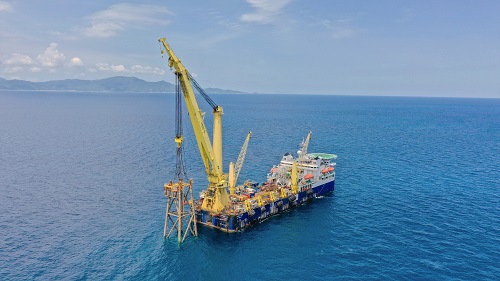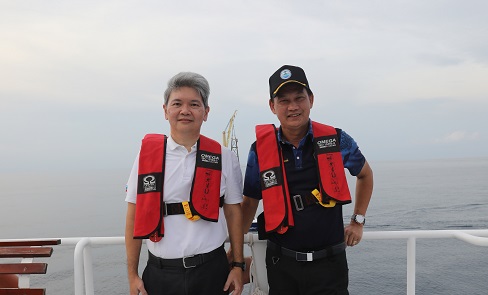press release DMCR, Chevron and CU joined hands to implement Thailand's first ever rigs-to-reefs project for marine conservation in Surat Thani

The picture of the placement execution of idle platform jackets as artificial reefs
The Department of Marine and Coastal Resources (DMCR), together with Chevron Thailand Exploration and Production, Ltd. (Chevron Thailand) and Chulalongkorn University (CU), have recently implemented the pioneering project on the use of 7 idle platform jackets as artificial reefs for marine and coastal resources conservation in Koh Pha-Ngan, Surat Thani. It is considered the first rigs-to-reefs project in Thailand. The placement of these artificial reefs has commenced from August 2020 and is expected to be completed by September 2020. On September 2, relevant authorities embarked on a field trip to observe and monitor the placement of the 4th idle platform jacket.
According to the resolution of the National Policy and Plan Committee for Marine and Coastal Resources Management (or the National Committee) on July 9, 2018, the 3 parties have enhanced their cooperation to study, monitor and evaluate the physical environment and the ecological components as well as benefits the artificial reefs modified from retired idle platform jackets can yield in the project’s area. The endeavor is vital in contributing to establishing Thailand’s knowledge on the subject. Other objectives include strengthening collaborative efforts to preserve and restore marine resources in Thailand.
Sopon Thongdee, DMCR Director-General, said “We have piloted mock-up petroleum jacket structures as artificial reefs in nearby Chalok Lam Bay, Koh Pha-Ngan since 2013. The study showed that these materials provide suitable habitats for marine life as well as benefit to tourism and fisheries. Moreover, this will be an income-generating project for the communities as well as potentially boost the growth of Thailand’s economy in the future. As outlined in the cooperation framework, the DMCR will supervise, evaluate and monitor the project’s area as well as coordinate with related agencies in the artificial reef placement process, as assigned by the national committee. Chevron Thailand will be the co-project owner alongside DMCR, providing the agency with 7 retired idle platform jackets to be modified and used as artificial reef materials as well as supporting its placement and the budget for the project. Chula Unisearch will be tasked with conducting and supporting relevant studies on the physical environment and the ecological components that meet local and international academic standard.
These underwater jackets are 70-84 meters in height with a base size of approximately 20-22.5 meters located at 38.5-39.5 meters below the water. After the structures are laid down onto the seabed, this will allow no less than 15 meters between the top of the reef pile and the sea surface for sailing safety. These jackets have been transported from the middle of the Gulf of Thailand to Koh Pha-Ngan at a distance of approximately 150-200 kilometers by a heavy lift vessel. This vessel can carry out heavy lift operations of up to 3,000 tons at sea (over 4-8 times of the actual jackets’ weight) which help increase work efficiency and safety of the operation. In addition, the artificial reef site will cover a 4 square-kilometer area while the artificial reef itself will cover an area of 0.05 square kilometers.
“We are certain that these artificial reefs would provide a suitable habitat and shelter for a wide variety of young marine species. The reefs could be a new deep-water diving site to accommodate tourist arrivals from Koh Pha-Ngan, Koh Samui, and Koh Tao in the near future, generating economic benefits and decreasing the number of leisure divers around the natural coral reefs. We are declaring the site a protected area to sustainably manage and maximize the future benefits in fisheries and tourism. The jackets’ relocation is supervised by the specialists from the DMCR together with government agencies in each stage, with the Chevron working team ensuring compliance with the world-class standard of environment and safety as well”, said the Director-General.

Sopon Thongdee (right), DMCR Director-General, and Ajj Tularak (Left), asset retirement manager, Chevron Thailand, along with the relevant authorities went on a field trip to observe and monitor the placement of the 4th platform jackets in Koh Pha-Ngan, Surat Thani
Ajj Tularak, asset retirement manager, Chevron Thailand Exploration and Production, Ltd., explained, “The seas around our petroleum platforms are rich with marine resources and the platform jackets have over time become artificial reefs in their own right. Their complex and durable structures are a perfect habitat of coral reefs and a wide variety of marine species. The relocation of the jackets closer to the shore or 7.5 nautical miles of Koh Pha-Ngan for the purpose of being converted into artificial reefs would enable an increase in marine resources as well as benefits to local economy through tourism and fisheries. Throughout the project operation, Chevron has placed the highest priority on safety, protection of marine resources and the ecological system, and conducted the project in accordance with national and international laws and regulations.
Spanning 2 years after the completion of these 7 jackets placement, DMCR, Chevron Thailand in collaboration with Chula Unisearch will jointly conduct a biological and ecological study on the project, tracking possible impact and benefits from the artificial reef placement. The study of this project is expected to help generate a body of knowledge on this historic use of artificial reefs converted from platform jackets to conserve marine life in the Gulf of Thailand and to aid the planning and management of coastal resources in national-scale management plans.